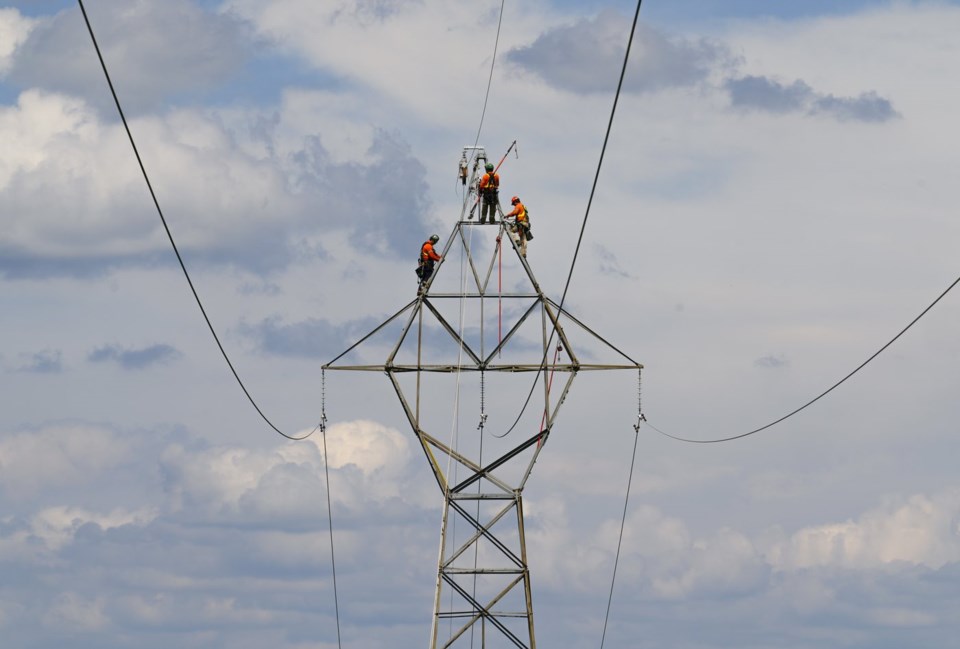TORONTO — The next Ontario government should take the lead in encouraging urgent expansion of interprovincial electricity transmission while ensuring it advances a transition to a clean economy, a new report by the Pembina Institute said Wednesday.
Reducing interprovincial barriers could open up new markets for Ontario's electricity that are insulated from ongoing trade uncertainty with the United States, the report said.
Ontario and the rest of Canada face a “new economic reality” highlighted by the threat of a prolonged trade dispute with the U.S., said the report published by the clean energy think tank. Yet, regardless of how those threats materialize, the report suggests a “major economic realignment” has started and Ontario must find a new path to ensure its economy is insulated against future shocks.
"The takeaway for Ontario is clear: developing a clean energy economy has the potential to make Ontarians’ lives more affordable and their homes and cities healthier and more comfortable, and to create new sectors and jobs," the report said.
The report underlines some of the recent trends in Ontario's electricity grid, electric vehicle manufacturing and purchasing, and building emissions before it offers a suite of recommendations on what reforms the next provincial government could pursue on a path to a lower-emissions economy.
There are some promising signs, the report said. Notably, the province initiated the largest ever battery storage procurement in Canada last year and recently approved a nearly $11 billion multi-year investment to help electricity consumers manage their use and costs.
But the report warned of possible pitfalls. While Ontario’s coal phaseout helped drop electricity emissions, the trajectory flipped in recent years.
The province’s grid went from 94 per cent emissions-free in 2020 to 87 per cent in 2024. That trend is set to continue due to forecasted growth in gas generation as the province refurbishes its nuclear generating stations, the report said.
"Not only does this risk undermining the province’s clean-grid progress, it exposes Ontarians to the price volatility and energy security threats from an overreliance on fossil fuel imports," the report said.
It suggests the next government should open up more areas of the province for possible solar projects, including prime agricultural lands, and ensure the provincial regulator and energy operator both have clear mandates to support the “rapid and ambitious electrification” of the economy.
While Ontario has made several major investments to help attract new electric vehicle manufacturers, the report suggests its domestic EV market still lags behind other provinces in the absence of more consumer-side policies. It has fewer chargers per capita than Canada’s national average and does not offer EV purchase rebates, unlike some other provinces.
Meanwhile, as people expand their search for affordable homes, they are facing longer commuters and higher transportation costs, the report said. It suggests EVs can save a driver thousands of dollars compared to a gas-powered vehicle on the full cost of ownership over a decade, despite the higher upfront cost in some cases.
"Helping consumers overcome that upfront cost is a key policy. Reducing the barriers to actually owning and operating an electric vehicle is really important and there's a lot the government can do to encourage more infrastructure," said Chris Severson-Baker, Pembina Institute's executive director.
The report suggests the province could bring in income-tested purchase incentives for some EVs and develop a plan for a provincewide charging network. It suggests Ontario could also kick-start manufacturing of electric school buses to replace roughly 20,000 diesel-powered vehicles and capitalize on what could be a growing North American market.
Meanwhile, a major driver of emissions in Ontario comes from heating and powering homes, offices and other buildings. Nearly a quarter of Ontario’s emissions comes from space and water heating provided by fossil fuels, the report noted.
In response, it suggests Ontario continue to invest in programs that help people afford energy efficient home retrofits. It also recommended revising the Ontario Building Code to require parking spaces in new residential buildings be EV-ready.
It also suggests Ontario incentivize and regulate disconnection of gas infrastructure from new builds.
Yet, the government recently stepped in to block a decision by the regulator on who should pay for new natural gas connections. The government last year overruled an Ontario Energy Board's decision to put building developers, not ratepayers, on the hook for costs of new gas connections.
This report by The Canadian Press was first published Feb. 19, 2025.
Jordan Omstead, The Canadian Press



